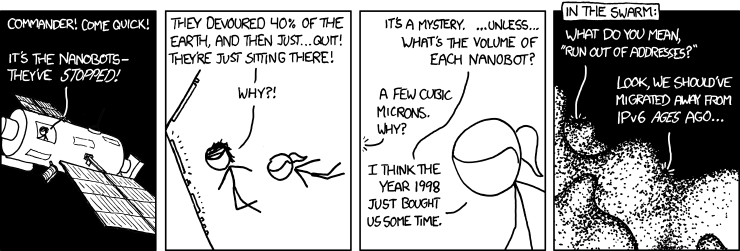The internet is a global-scale, technically complex artefact of immense international social and political importance. It is formed by the interaction of technical constraints (e.g. speed of light, number of addresses), usage models and behaviour, technological design choices and policy decisions.
This course will focus on the Internet and other networks will only marginally be mentioned (mobile networks, local networks, etc.), even if they are converging. Applications of the Internet such as the Web and social networks and other online services are not covered.
Networking History
One of the earliest networks was developed by Claude Chappe (1763-1805), a mechanical semaphore. In 1837 the electrical telegraph allowed transmission of Morse code. In 1866 there was a connection between London and New York at a price of 20 words for 100$. In 1863 Reiss developed telephony. In 1895 the first wireless communication was demonstrated, in 1906 radio was broadly introduced. Television was broadcast in 1928.
The Internet is based on packet-switching which was first demonstrated by Kleinrock in 1961 (Kleinrock, 1961) . In 1964 Baran created military nets using packet-switching (Baran, 1964) . In 1967 the ARPAnet was conceived and installed in 1969. In 1972 the ARPAnet had 15 nodes. In 1973 Metcalfe proposed Ethernet (Metcalfe & Boggs, 1976) . Vinton G. Cerf & Robert E. Kanhn’s itnernetworking principles developed in 1974 (Cerf & Kahn, 1974) . In 1979 the ARPAnet has 200 nodes.
The Internet was commercialised in the 1990s. The ARPAnet was decommissioned. The NSFnet in 1991 allows commercial use and is itself shutdown in 1995 and replaced by the World Wide Web (WWW). In the 2000s the dotcom-bubble for the first time shot the impact potential of the Internet on the real world.
Internet Basics
The Internet carries packets. Packets have headers that describe them, a payload which contains their contents. Officially, Internet routers only care about packets. The explicit analogy is like mailing a letter (inside the envelope is the payload/letter and the headers equals the address on the envelope). This differs to telephone traffic where the traffic is analysed to optimise the traffic (fax versus voice call).
IP addresses have 32 bits and therefore can approximately connect 4 billion devices. An IP address has become a scarce resource. The question arises who allocates addreses, who can be reached globally and should a new protocol be adopted? IP version 6 has been proposed as the solution.

A protocol defines a set of messages that are sent between end-points and define what these messages mean and what end-points should do with these messages.The internet protocol stack consists of 5 layers: physical, link, network, transport and application. Throughout this course we will focus on transport and network.
The data send in a message will get an additional header for each layer that it traverses. The Internet has at the core the IP and does not change this (“narrow waist model”). The layers above (transport and application) or below (physical, link) can be arbitrarily changed. Side note: in Germany successfully carry pigeons were used to send a message. The rigidity of IP is claimed to be the reason for the success of the Internet. In reality, their are many more layers, there have been observed real world packets with 12 layers and more where the IP layer is repeated multiple times. HTTP has become the main protocol, and other protocols are often blocked, consequently, much traffic that is not actually text (e.g. video) is send over it.
The Internet consists of many autonomous system (Internet Service Providers (ISP)) that communicate via Border Gateway Protocol (BGP). Each system advertises where it can delivers messages to, however, they need not be truthful. Incidents include advertising optimal routes to everywhere to attract all traffic (including special regions). Another alternative is to advertise a route that is cheap, but never deliver the packet. It is not clear how to resolve such misuse of the system.
The Internet has been designed insulated from commercial and political pressures, but the reality has changed. The idea for the Internet and the real-world use have diverged. The course focuses on the tension between technology, policy, commerce and politics.